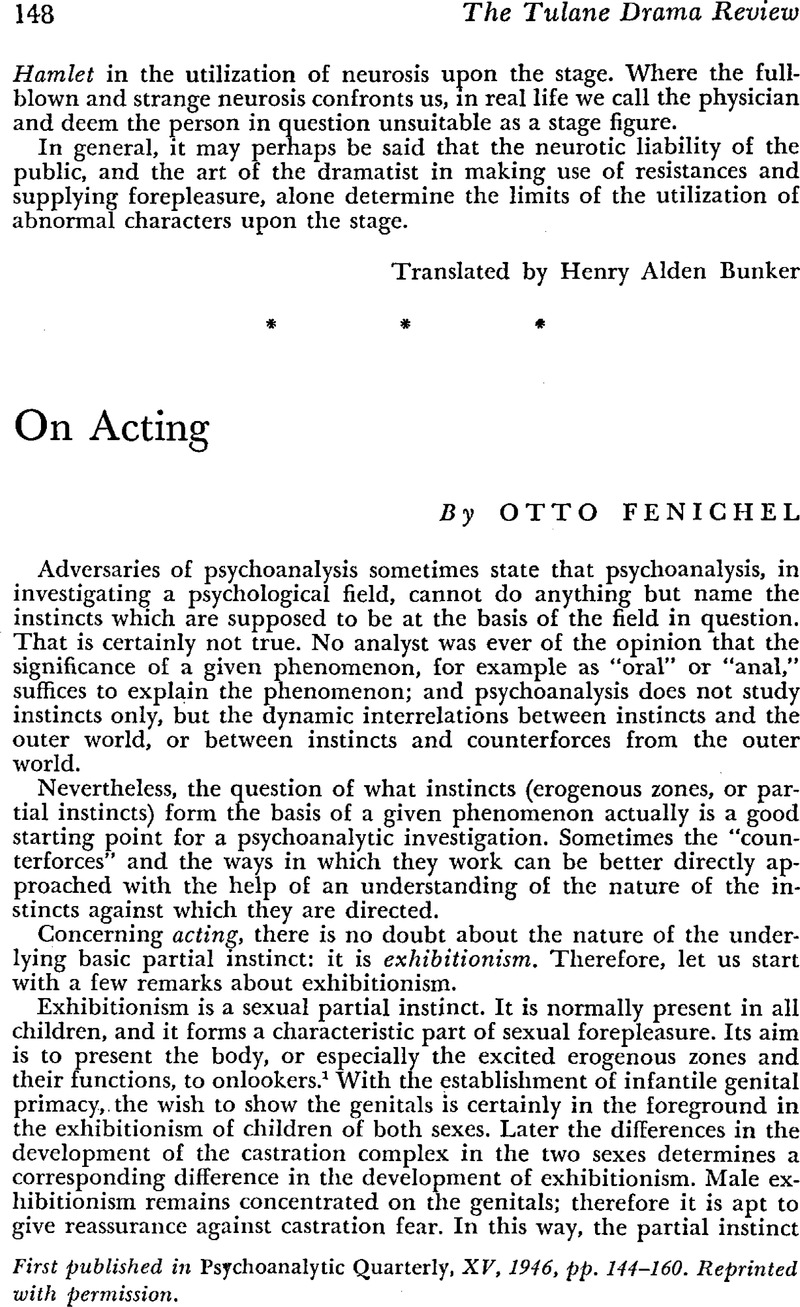No CrossRef data available.

1 S. Freud, Three Essays on the Theory of Sexuality, London, Imago, 1949.
2 Cf. Harnik, J., “The Various Developments Undergone by Narcissism in Men and Women,” Int. J. Psa., Vol. 5, 1924.Google Scholar
3 For a more detailed discussion of these points and for the literature, cf. O. Fenichel, “Early Stages of Ego Development,” No. 3 in this volume.
4 Freud, S., “Medusa's Head,” Collected Papers, Vol. 5, London, Hogarth, 1950.Google Scholar
5 Cf. Klein, M., “Personification in the Play of Children,” Int. J. Psa., Vol. 10, 1929.Google Scholar
6 Freud, S., Beyond the Pleasure Principle, London, Hogarth, 1948.Google Scholar Cf. also the summary by Waelder, R., “The Psychoanalytic Theory of Play,” Psa. Quart., Vol. 2, 1933.Google Scholar
7 Cf. Deutsch, H., “Ueber die pathologische Luege (Pseudologia phantastica),” Int. Z. Psa., Vol. 8, 1922Google Scholar; and O. Fenichel, “The Economics of Pseudologia Phantastica,” No. 9 in this volume.
8 The “phantoms” are developed under the influence of real experiences and represent earlier identifications, not necessarily identifications with real objects but also with objects as the child saw them, or as the child would have liked them to be. Cf. Wittels, F., “Unconscious Phantoms in Neurotics,” Psa. Quart., Vol. 8, 1939.Google Scholar
9 The imitation of idealized persons often represents an attempt to “try out” their ways of feeling, without losing the knowledge of the “trial” character. The “test” character of such limited “identifications” in the service of some purpose of the ego, differentiates imitation from full identification, which takes place unconsciously and independently of the ego's wishes.
10 H. Sachs, Caligula, London, Elkin Mathews & Marrot, 1931.
11 Sachs, H., The Creative Unconscious; Studies in the Psychoanalysis of Art, Cambridge, Sci-Art, 1942.Google Scholar
12 Cf. O. Fenichel, “The Scoptophilic Instinct and Identification,” No. 33, First Series.
13 Ferenczi, S., “Stages in the Development of the Sense of Reality,” Sex in Psychoanalysis, New York, Brunner, 1950.Google Scholar
14 It would be interesting to compare the psychology of the scenario writer, who is furnished the complete plot of a story and prepares the script from it, with the psychology of the playwright.
15 Cf. Kris, E. and Kurz, O., Die Legende vom Kuenstler, Vienna, Krystallyerlag, 1934.Google Scholar
16 There are many reasons why this position of the artist is especially marked for the actor. The theatre has retained certain archaic features which, by their very archaic nature, are apt to mobilize repressed impulses and to arouse ambivalent feelings. The actors were, for long periods, nomads—like the gypsies—while all others had long settled. Actors are also looked upon like gypsies, and gypsies were often performers. Cf. O. Fenichel, “Elements of a Psychoanalytic Theory of Anti-Semitism,” No. 25 in this volume.
17 Reich, A., “The structure of the Grotesque-Comic Sublimation,” Bull. Menninger Clin., Vol. 13, 1949.Google Scholar
18 The same mechanism can often be observed in people who like to “perform” by telling jokes. An unconscious aggression may be given expression if hidden in the form of a joke, particularly if one succeeds in inducing the audience to participate in the aggression. But this too may have a “doubleedged character.” The fear is that a real magical effect of the joke might destroy its character as a joke. Cf. S. Freud, “Wit and Its Relation to the Unconscious,” The Basic Writings, New York, 1938.
I once analyzed the traditional figure of the “clown” as the exhibition of a phallic figure, which has been regressively debased to the pregenital level for the purpose of denying the seriousness of castration. The many stories of the uncanny tragic clown represent the failure of these attempts. Cf. O. Fenichel, “The Symbolic Equation: Girl = Phallus,” No. 1 in this volume.
19 1 do not remember any published case of the psychoanalysis of stage fright. There is a great deal of literature about the related symptoms such as fear of examinations and erythrophobia: Blum, E., “The Psychology of Study and Examinations.” Int. J. Psa., Vol. 7, 1926Google Scholar; Flugel, J. C., “The Examination as Initiation Rite and Anxiety Situation,” Int. J. Psa., Vol. 20, 1939Google Scholar; Stengle, E., “Pruefungsangst und Pruefungsneurose,” Z. Psa. Paed., Vol. 10, 1936Google Scholar; E. Jones, “Pathology of Morbid Anxiety,” Papers on Psychoanalysis, 4th ed., Baltimore, Wood, 1938; Feldmann, S., “Ueber das Erroeten. Beitrag zur Psychologie der Scham,” Int. Z. Psa., Vol. 8, 1922.Google Scholar
20 Compulsive mechanisms of actors have unconsciously the meaning of ensuring that acting is only “playing” to overcome stage fright. “Getting stuck” may express the resistance against any tendency which was supposed to find an outlet in the acting. It may also have the much more specific meaning of “getting stuck” before the castrated state, which one had intended to play, is achieved; and/or “getting stuck” in the castrated state.